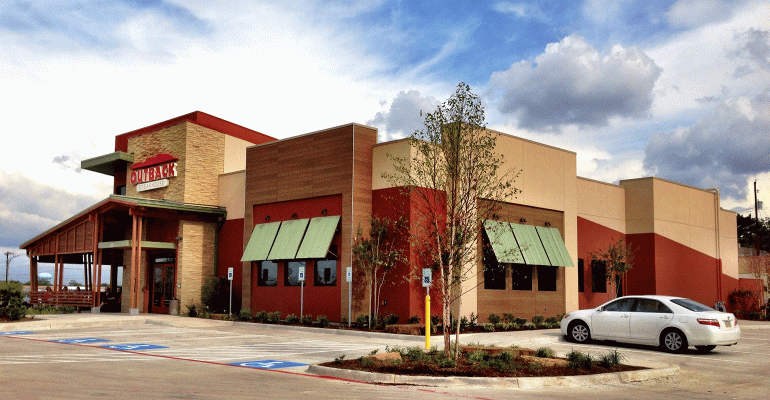Executives with Outback Steakhouse owner Bloomin’ Brands Inc. said on Friday that same-store sales at all four of its chains turned positive in October — sending shares higher despite weak earnings.
Same-store sales at its four brands declined by 1 percent in the quarter ended Sept. 24 — a decline the company blames in part on the impact of hurricanes Harvey and Irma, which had a 1-percent impact on comparable store sales.
Outback same-store sales rose 0.6 percent in the period, including a 1-percent increase in traffic. Carrabba’s Italian Grill same-store sales declined by 2.8 percent, Bonefish Grill down 4.3 percent, and Fleming’s Prime Steakhouse same-store sales fell 1 percent.
Yet all four companies turned positive in October, CEO Liz Smith said on Friday.
“All our brands are performing very strongly in October,” Smith said. “They’re meaningfully outperforming the industry.”
That includes Outback, which has now seen three straight positive quarters and, according to Bloomin’ Brands, outperformed casual dining traffic by 490 basis points.
While the company would not provide specifics, Smith said that gap widened in October.
Executives’ comments on the October performance offset what investors initially viewed as a weak quarter for the Tampa-based casual-dining operator. The company’s stock, which was down as much as 7 percent early Friday morning, rebounded into positive territory by midday.
Bloomin’ reported adjusted diluted earnings per share of 12 cents, far weaker than the 19-cents EPS it recorded the same period a year ago. That fell short of investors’ expectations in the quarter.
Net income in the period was $4.3 million, down 80 percent from a year ago. Revenues declined 6 percent to $948 million.
The company also lowered its guidance for earnings. It now expects to generate adjusted EPS of $1.31 to $1.36, down from the $1.40 to $1.47 Bloomin’ Brands originally expected.
Yet executives said that hurricanes had a major impact on the company’s performance in the period. Executives said that hurricanes hurt EPS by 4 cents, in addition to the same-store sales impact.
Carrabba’s and Bonefish were particularly hurt. Roughly 30 percent of the chains’ locations were in the paths of the dual storms, executives said. “The hurricanes had a very big impact on Carrabba’s and Bonefish,” Smith said.
Still, Smith said that even without the hurricanes the casual dining sector just had the worst quarter since the recession. “It was significantly softer than what we’d seen thus far this year,” she said.
Part of the improvement in October could from a bounce-back from weakness in September. But Smith said that the improvement is coming in all brands and all geographies. “This is not a rebound story for us,” she said.
Still, continuing volatility is giving executives some pause about making any promises for the rest of the year.
In particular: December. Much of Bloomin’s sales for the period come during the holiday season. A year ago, however, sector traffic plunged as consumers shopped more at home and less at malls and other retail areas.
The fourth quarter “is largely driven by what happens between Thanksgiving and New Years,” Smith said. “Last year it was down 7 percent. Given the volatility in the retail outlook, we remain cautious in our outlook for the Q4 holiday season.” She added that the “retail landscape hasn’t settled.”
Executives believe the company has strategies in place that could bolster sales during that period even with a challenging environment, though they wouldn’t provide details.
Bloomin’ has gone big into loyalty. Its DineRewards loyalty program, available at all four of its concepts, has 4.8 million members and generated a 200-basis point increase in sales, executives said.
The company is also a big believer in the potential of delivery. Smith has said repeatedly that the consumer landscape is changing, and that consumers want to eat at home more often.
The company has delivery in 246 locations and is working to ensure that food is delivered within 30 to 40 minutes. Smith said that delivery orders tend to be larger than other orders.
“The opportunity is looking very robust,” Smith said. “We want to make sure we have the space, staff and pacing to deliver on consumer expectations, which are about 30 to 40 minutes for delivery. We’re going to go slow to go fast.”
Contact Jonathan Maze at [email protected]
Follow him on Twitter: @jonathanmaze

